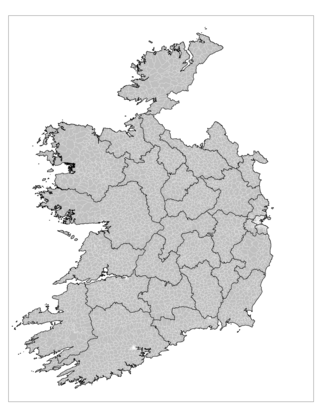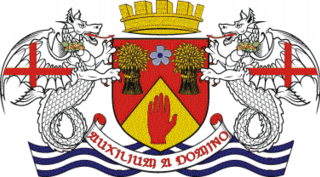
Portlaoise, or Port Laoise, is the county town of County Laois, Ireland. It is located in the South Midlands in the province of Leinster.

County Laois is a county in Ireland. It is part of the Eastern and Midland Region and in the province of Leinster. It was known as Queen's County from 1556 to 1922. The modern county takes its name from Loígis, a medieval kingdom. Historically, it has also been known as County Leix.
Dublin County Council was a local authority for the administrative county of County Dublin in Ireland.

The Local Government (Ireland) Act 1898 was an Act of the Parliament of the United Kingdom of Great Britain and Ireland that established a system of local government in Ireland similar to that already created for England, Wales and Scotland by legislation in 1888 and 1889. The Act effectively ended landlord control of local government in Ireland.

An electoral division is a legally defined administrative area in the Republic of Ireland, generally comprising multiple townlands, and formerly a subdivision of urban and rural districts. Until 1996, EDs were known as district electoral divisions in the 29 county council areas and wards in the five county boroughs. Until 1972, DEDs also existed in Northern Ireland. The predecessor poor law electoral divisions were introduced throughout the island of Ireland in the 1830s. The divisions were used as local-government electoral areas until 1919 in what is now the Republic and until 1972 in Northern Ireland.

Clare County Council is the local authority of County Clare, Ireland. As a county council, it is governed by the Local Government Act 2001. The council is responsible for housing and community, roads and transportation, urban planning and development, amenity and culture, and environment. The council has 28 elected members who are elected for a five-year term. The head of the council has the title of Cathaoirleach (chairperson). The county administration is headed by a chief executive, Pat Dowling. The county town is Ennis.

Cavan County Council is the authority responsible for local government in County Cavan, Ireland. As a county council, it is governed by the Local Government Act 2001. The council is responsible for housing and community, roads and transportation, urban planning and development, amenity and culture, and environment. The council has 18 elected members. Elections are held every five years and are by single transferable vote. The head of the council has the title of Cathaoirleach (chairperson). The county administration is headed by a chief executive, Tommy Ryan. The county town is Cavan.

Carlow County Council is the local authority of County Carlow, Ireland. As a county council, it is governed by the Local Government Act 2001. The council is responsible for housing and community, roads and transportation, urban planning and development, amenity and culture, and environment. The council has 18 elected members. The head of the council has the title of Cathaoirleach (chairperson). The county administration is headed by a chief executive, Kathleen Holohan. The county town is Carlow.

Kerry County Council is the local authority of County Kerry, Ireland. As a county council, it is governed by the Local Government Act 2001. The council is responsible for housing and community, roads and transportation, urban planning and development, amenity and culture, and environment. The council has 33 elected members. Elections are held every five years and are by single transferable vote. The head of the council has the title of Cathaoirleach (chairperson). Since 21 June 2024, Breandán Fitzgerald of Fianna Fáil has served in the role. The county administration is headed by a chief executive, Moira Murrell. The county town is Tralee.

Laois County Council is the local authority of County Laois, Ireland. As a county council, it is governed by the Local Government Act 2001. The council is responsible for housing and community, roads and transportation, urban planning and development, amenity and culture, and environment. The council has 19 elected members. Elections are held every five years and are by single transferable vote. The head of the council has the title of Cathaoirleach (chairperson). The county administration is headed by a chief executive, John Mulholland. The county town is Portlaoise.

Waterford County Council was the authority responsible for local government in County Waterford, Ireland. The remit of Waterford County Council also included some suburbs of the Waterford city not within the remit of Waterford City Council. As a county council, it was governed by the Local Government Act 2001.

Offaly County Council is the local authority of County Offaly, Ireland. As a county council, it is governed by the Local Government Act 2001. The council is responsible for housing and community, roads and transportation, urban planning and development, amenity and culture, and environment. The council has 19 elected members. Elections are held every five years and are by single transferable vote. The head of the council has the title of Cathaoirleach (chairperson). The county administration is headed by a chief executive, Anna Marie Delaney. The county town is Tullamore.

Cork County Council is the local authority of County Cork, Ireland. As a county council, it is governed by the Local Government Act 2001, as amended. The council is responsible for housing and community, roads and transportation, urban planning and development, amenity and culture, and environment. The council has 55 elected members. Elections are held every five years and are by single transferable vote. The head of the council has the title of Mayor. The county administration is headed by a chief executive, Valerie O'Sullivan. The county seat is Cork.

North Tipperary County Council was the local authority of the county of North Tipperary, Ireland, from 1899 to 2014. The head of the council had the title of Mayor. The county town was Nenagh.

Fermanagh County Council was the authority responsible for local government in County Fermanagh, Northern Ireland, between 1899 and 1973. It was originally based at the Enniskillen Courthouse, but moved to County Buildings in East Bridge Street, Enniskillen, in 1960.

Antrim County Council was the authority responsible for local government in County Antrim, Northern Ireland.

Down County Council was the authority responsible for local government in County Down, Northern Ireland.

Portlaoise Courthouse is a judicial facility in Portlaoise, County Laois, Ireland.

Armagh County Council was the authority responsible for local government in County Armagh, Northern Ireland.

Londonderry County Council was the authority responsible for local government in County Londonderry, Northern Ireland.



















